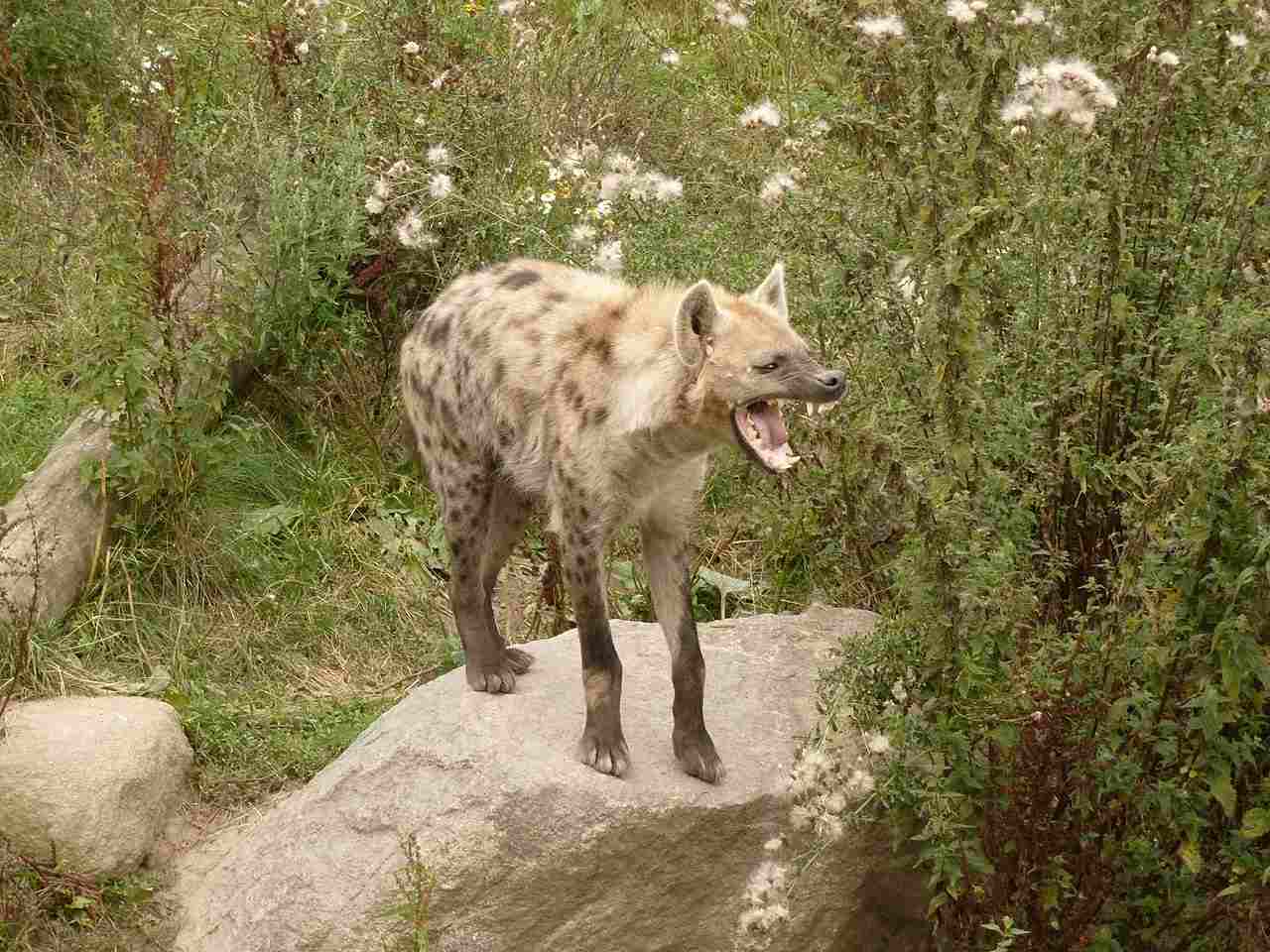Hyena Vs Wild Dog Size, Weight, Ecological Comparison
The hyena’s strength, size, predatory nature, and powerful bite force give it the advantage over the African wild dog in a physical confrontation, which means that, on average, a hyena will kill a wild dog if they engage in such a confrontation.
Within this article, we will explore various factors that can be used to compare these animals.
We will delve into their taxonomy, appearance, size, weight, speed and agility, overall physical capacity, habitat, lifespan, behavior, reproduction, danger posed to humans, intelligence, tracks, and conservation status. By examining these aspects, we can gain a comprehensive understanding of the differences between hyenas and wild dogs.
Reasons Why a Hyena Will Win a Wild Dog In a Fight/Physical Confrontation
I). Strength and Size Advantages
One of the main reasons why a hyena would win in a fight or physical confrontation against a wild dog is due to its strength and size advantages. Hyenas are larger and more robust compared to wild dogs, giving them a significant physical advantage. With their stocky build and powerful muscles, hyenas have the ability to overpower and dominate wild dogs in a confrontation.
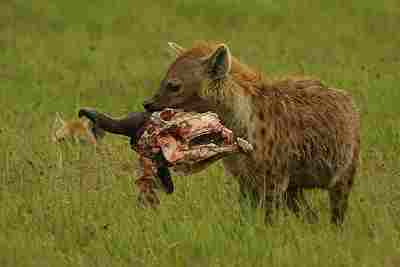
II). Predatory Superiority
Hyenas are apex predators, while wild dogs are considered to be opportunistic hunters. This predatory superiority gives hyenas an edge in a fight. Hyenas have evolved to be efficient hunters and scavengers, with a keen sense of smell and excellent tracking abilities. They are known for their relentless pursuit of prey and their ability to take down large animals, which makes them formidable opponents in a physical confrontation.
III). Stronger Bite Force
Another reason why a hyena would likely win in a fight against a wild dog is their stronger bite force. Hyenas have one of the strongest bite forces among mammals, allowing them to crush bones and tear through tough hides. This powerful bite can cause severe damage to their opponents, giving them a clear advantage in a physical confrontation.
*Details of Comparison
1). Taxonomy
The taxonomy of hyenas and wild dogs reveals interesting differences between the two species. Hyenas belong to the genus Crocuta, with the spotted hyena (Crocuta crocuta) being the most well-known species. On the other hand, wild dogs, also known as African painted dogs, belong to the genus Lycaon, with the scientific name Lycaon pictus.
In terms of their classification, hyenas and wild dogs are both members of the Carnivora order and the Canidae family. However, they belong to different subfamilies, with hyenas belonging to the subfamily Hyaeninae and wild dogs belonging to the subfamily Caninae.
2). Appearance
The appearance of hyenas and wild dogs showcases distinct characteristics that set them apart. Starting with their coats, hyenas have a coarse and shaggy fur, while wild dogs possess a short and smooth coat. This difference in fur texture is crucial for their respective habitats and survival strategies.
Hyenas have a unique coloration pattern with brown or grayish fur covered in irregular dark spots. This camouflage helps them blend into their surroundings, making it easier to approach prey or hide from potential threats. On the other hand, wild dogs exhibit a striking coat pattern with a mix of black, white, and brown patches. This coloration serves as a visual signal within their pack, aiding in communication and coordination during hunts.
In terms of stature and build, hyenas are known for their robust and stocky bodies, with a sloping back and powerful forequarters. This physique enables them to exert strength and dominance during confrontations. In contrast, wild dogs have a more slender and streamlined build, designed for endurance and agility. Their long legs and lean bodies allow them to cover vast distances while chasing down prey.
3). Size
When comparing the size of hyenas and wild dogs, it is important to consider their total body length and height at the shoulders. Hyenas are generally larger than wild dogs in terms of both length and height.
Hyenas can reach a total body length of up to 5.6 feet (1.7 meters) and stand at a height of around 2.6 feet (0.8 meters) at the shoulders. On the other hand, wild dogs have a total body length of approximately 3.9 to 4.9 feet (1.2 to 1.5 meters) and a shoulder height of about 2.3 to 2.6 feet (0.7 to 0.8 meters).
The difference in size between these two species is significant and can have implications for their hunting strategies and interactions with other animals. The larger size of hyenas gives them an advantage in terms of physical strength and dominance, allowing them to overpower prey and defend their territories more effectively.
However, it is important to note that wild dogs compensate for their smaller size with their exceptional teamwork and cooperative hunting techniques. Their agility and speed enable them to chase down prey efficiently, making up for their relatively smaller stature.
While hyenas are generally larger than wild dogs in terms of size, the latter species has developed unique adaptations and hunting strategies to thrive in their respective environments. Size alone does not determine the success or superiority of these animals in their natural habitats.
4). Weight
When comparing the weight of hyenas and wild dogs, it is evident that hyenas are significantly heavier than wild dogs. Hyenas can weigh anywhere between 90 to 190 pounds (40 to 86 kilograms), depending on the species. On the other hand, wild dogs weigh around 40 to 70 pounds (18 to 32 kilograms).
The difference in weight between these two species is substantial and has implications for their hunting and survival strategies. The larger size and weight of hyenas provide them with more power and strength, allowing them to take down larger prey and defend their territories more effectively. Their robust build and strong jaws enable them to overpower and consume carcasses that other predators may struggle with.
In contrast, wild dogs rely on their agility, speed, and teamwork rather than sheer size and weight. Their lighter build allows them to be more nimble and swift, making them highly efficient hunters. They are known for their endurance and ability to chase down prey over long distances, relying on their pack dynamics to bring down larger animals.
While hyenas outweigh wild dogs significantly, the latter species compensates for their smaller size with their exceptional hunting techniques and cooperative behavior.
5). Speed and Agility
When comparing the speed and agility of hyenas and wild dogs, it becomes clear that these two species have distinct hunting strategies. Hyenas are known for their endurance and ability to cover long distances in search of prey. They can reach speeds of up to 37 miles per hour (60 kilometers per hour) and maintain a steady pace for extended periods. This allows them to chase down their prey and wear them out before launching an attack.
On the other hand, wild dogs are renowned for their exceptional speed and agility. They are one of the fastest land animals, capable of reaching speeds of up to 44 miles per hour (70 kilometers per hour). Their slender build and long legs enable them to swiftly maneuver through various terrains, making them highly efficient hunters. Their agility allows them to change direction quickly, making it difficult for their prey to escape.
While both hyenas and wild dogs possess impressive speed and agility, their hunting techniques differ. Hyenas rely on endurance and persistence, while wild dogs utilize their speed and agility to outmaneuver and chase down their prey.
6). Bite Force
Hyenas have one of the strongest bite forces among mammals, with an average psi of around 1,100. This powerful bite allows them to crush bones and access the nutrient-rich marrow inside. On the other hand, wild dogs have a slightly lower bite force, with an average psi of around 500. While not as strong as hyenas, wild dogs still have a formidable bite that enables them to take down their prey efficiently.
The difference in bite force between hyenas and wild dogs can be attributed to their feeding habits and jaw structure. Hyenas have robust skulls and strong jaw muscles, which are adapted for their scavenging lifestyle and the need to break through tough bones. In contrast, wild dogs have a more slender skull and jaw structure, which is better suited for capturing and killing prey through suffocation rather than bone-crushing.
While hyenas have a significantly stronger bite force compared to wild dogs, it is important to note that bite force alone does not determine the outcome of a confrontation between these two species. Factors such as hunting strategies, pack dynamics, and overall physical capacity also play roles in determining the outcome of such encounters.
7). Overall Physical Capacity (Which is Stronger?)
When comparing the overall physical capacity of hyenas and African wild dogs, it is clear that the hyena possesses greater strength. The hyena’s larger size, heavier weight, and greater muscle mass give it a distinct advantage in a violent confrontation.
Hyenas are known for their robust build, with strong bones and powerful muscles that allow them to take down large prey and crush bones with their impressive bite force. In contrast, African wild dogs have a more slender physique, which is better suited for agility and speed rather than raw strength.
In terms of size, hyenas are significantly larger than African wild dogs. Adult hyenas can weigh up to 190 pounds, while wild dogs typically weigh around 55 pounds. This size difference gives hyenas a clear advantage in terms of physical dominance.
Furthermore, hyenas have a well-developed social structure and hunt in organized groups, known as clans. This cooperative hunting strategy allows them to take down larger prey and defend themselves against potential threats. African wild dogs, on the other hand, rely on their speed and endurance to chase down smaller prey in packs.
While both hyenas and African wild dogs have their own unique physical adaptations, the hyena’s larger size, heavier weight, and greater muscle mass make it the stronger of the two species in a violent confrontation.
8). Habitat
Hyenas are highly adaptable and can be found in a wide range of habitats, including savannas, grasslands, woodlands, and even deserts. They have a broad geographic range that spans across Africa, the Middle East, and parts of Asia. This adaptability allows hyenas to thrive in various environments and take advantage of different food sources.
On the other hand, African wild dogs have more specific habitat requirements. They prefer open woodlands, grasslands, and savannas, where they can utilize their exceptional speed and agility during hunts. Their geographic range is limited to sub-Saharan Africa, with a few scattered populations remaining.
The differences in habitat preferences between hyenas and African wild dogs are closely linked to their hunting strategies and social behaviors. Hyenas, with their ability to adapt to different environments, can scavenge for food and take advantage of carcasses left behind by other predators. African wild dogs, on the other hand, rely on their speed and teamwork to chase down and capture live prey.
While hyenas have a broader habitat range and can adapt to various ecosystems, African wild dogs have more specific habitat requirements and are limited to sub-Saharan Africa.
9). Lifespan
When comparing the lifespan of hyenas and African wild dogs, there are notable differences between the two species. Hyenas have a relatively long lifespan, with individuals living up to 25 years in the wild. This extended lifespan can be attributed to their adaptability, social structure, and scavenging behavior, which allows them to access a wide range of food sources.
On the other hand, African wild dogs have a shorter lifespan compared to hyenas. In the wild, they typically live for about 10 to 12 years. This shorter lifespan can be attributed to various factors, including their hunting strategies, vulnerability to diseases, and competition with other predators for resources.
The difference in lifespan between hyenas and African wild dogs can also be influenced by their reproductive patterns. Hyenas have a slower reproductive rate, with females giving birth to one or two cubs every two to three years. In contrast, African wild dogs have a higher reproductive rate, with females giving birth to larger litters of up to 10 pups every year.
Hyenas have a longer lifespan compared to African wild dogs. This can be attributed to their adaptability, scavenging behavior, and slower reproductive rate.
10). Behavior
Hyenas exhibit a wide range of behaviors, including feeding, aggression, vocalization, social interactions, and parenting. They are known for their scavenging behavior, often stealing kills from other predators. Hyenas are highly social animals, living in large groups called clans. Within these clans, there is a strict hierarchy, with dominant females leading the group. They communicate through a variety of vocalizations, including whoops, growls, and giggles. Hyenas also exhibit cooperative parenting, with females sharing the responsibility of raising their young.
On the other hand, African wild dogs have a different set of behaviors. They are highly social animals, living in packs consisting of an alpha male and female, along with their offspring. These packs work together to hunt and raise their young. African wild dogs are known for their unique vocalizations, including high-pitched chirps and twittering sounds. They have a complex social structure, with a strong sense of cooperation and communication within the pack.
Therefore, hyenas and African wild dogs have distinct behavioral patterns. Hyenas exhibit scavenging behavior, social hierarchy, and cooperative parenting, while African wild dogs display cooperative hunting, unique vocalizations, and a strong sense of pack cooperation. These behavioral differences contribute to the unique ecological roles and adaptations of each species.
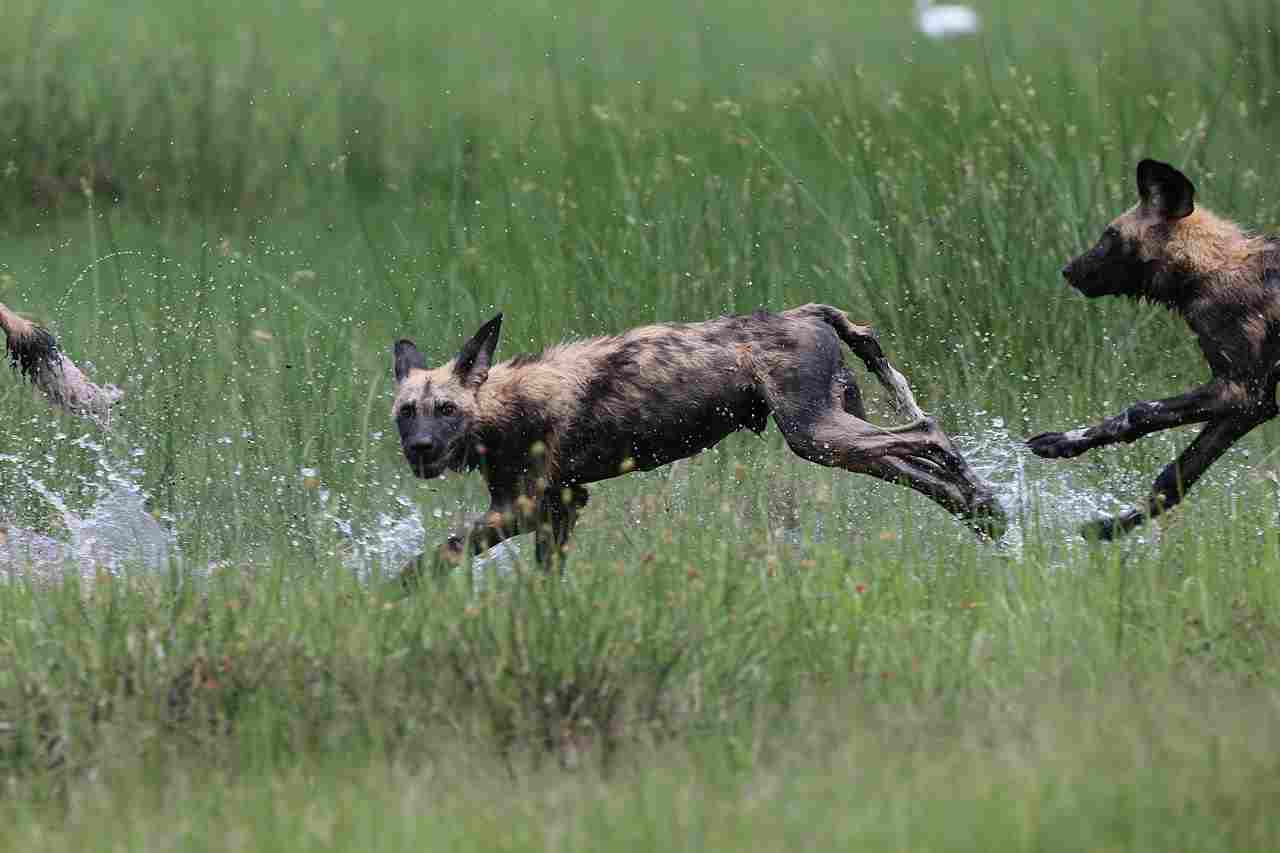
11). Reproduction
When it comes to reproduction, hyenas and African wild dogs have distinct strategies. Hyenas are viviparous, meaning they give birth to live young. The gestation period for hyenas is around 110 days, and they typically give birth to one to four cubs at a time. The cubs are born with their eyes open and are able to walk shortly after birth. Hyena cubs are highly dependent on their mothers for the first few months of their lives.
On the other hand, African wild dogs are also viviparous, giving birth to live young. The gestation period for African wild dogs is slightly shorter, lasting around 70 days. They typically have larger litters, with an average of six to ten pups. The pups are born blind and helpless, relying on their parents and the rest of the pack for care and protection. African wild dog pups are weaned at around two months old and start participating in hunts with the pack at around six months old.
In terms of reproduction, hyenas and African wild dogs have different gestation periods and litter sizes. Hyenas have a longer gestation period but smaller litters, while African wild dogs have a shorter gestation period but larger litters. These differences in reproductive strategies contribute to the survival and population dynamics of each species in their respective habitats.
12). Danger Posed to Humans
Hyenas are known to come close to human settlements, especially in areas where there is easy access to food sources such as garbage dumps. While they are generally not aggressive towards humans, there have been instances where hyenas have attacked and injured people, particularly if they feel threatened or if they are protecting their young. However, the rate of human deaths caused by hyenas is relatively low compared to other large predators.
On the other hand, African wild dogs are generally not a threat to humans. They are shy and elusive animals that tend to avoid human settlements. African wild dogs have a natural fear of humans and will typically flee if they encounter them. As a result, the rate of human deaths caused by African wild dogs is extremely rare.
If you do happen to encounter either a hyena or an African wild dog in the wild, it is important to exercise caution and take certain precautions. Avoid approaching them or getting too close, as this can provoke defensive behavior. Instead, observe them from a safe distance and give them space to move away. It is also advisable to make noise or wave your arms to deter them from approaching.
While both hyenas and African wild dogs have the potential to pose a danger to humans, hyenas are more likely to come close to human settlements and may exhibit aggressive behavior if provoked. African wild dogs, on the other hand, are generally not a threat and will avoid human interaction whenever possible.
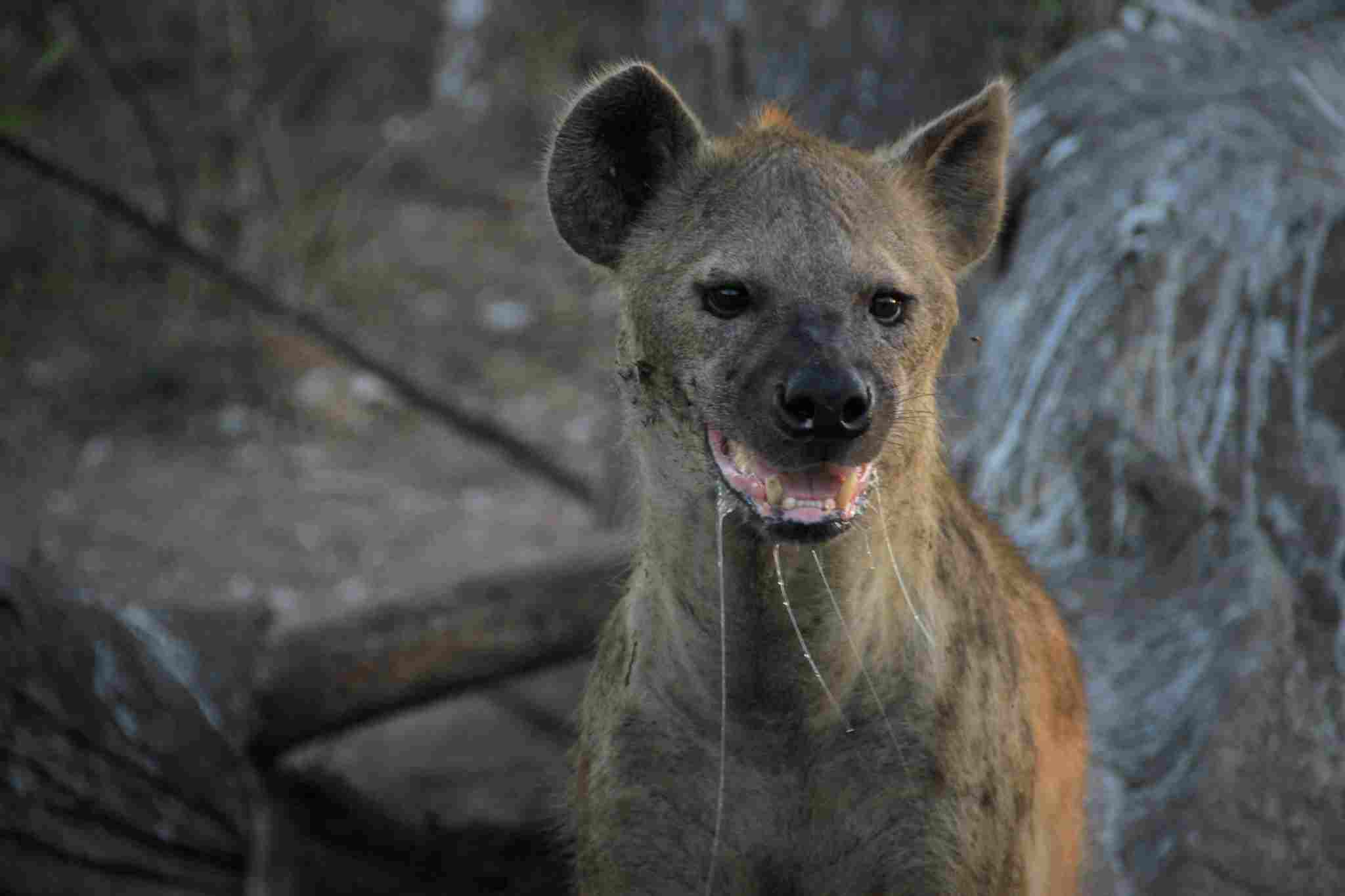
13). Intelligence
Both hyenas and African wild dogs exhibit remarkable cognitive abilities. However, there are some notable differences between the two.
Hyenas are known for their problem-solving skills and adaptability. They have been observed using cooperative hunting strategies, where they work together to bring down larger prey. This requires a high level of coordination and communication among the members of the hyena clan. Additionally, hyenas have shown the ability to remember and recognize individual members of their clan, which helps maintain social bonds and hierarchy.
On the other hand, African wild dogs are highly intelligent in their own right. They have a complex social structure and rely on effective communication to coordinate their hunting efforts. African wild dogs use vocalizations, body language, and even facial expressions to convey information to other members of their pack. They also demonstrate exceptional problem-solving skills, especially when it comes to finding and accessing food sources.
In terms of which animal is more intelligent, it is difficult to determine definitively. Both hyenas and African wild dogs have evolved unique cognitive abilities that are well-suited to their respective ecological niches. While hyenas may have a slight edge in terms of problem-solving and social complexity, African wild dogs excel in their communication skills and adaptability to changing environments.
14). Tracks
When comparing the tracks of hyenas and African wild dogs, there are some distinct differences. Hyena tracks are typically larger and more rounded, with four toes and claw marks visible. Their tracks often show a clear imprint of the pad, which can help identify the species. On the other hand, African wild dog tracks are smaller and more elongated, resembling those of domestic dogs. They have four toes as well, but their claw marks are usually less prominent.
In terms of behavior, hyenas are known for their scavenging habits and are often associated with the presence of bones and carcasses. This can be reflected in their tracks, as they may show signs of digging or disturbance around food sources. African wild dogs, on the other hand, are skilled hunters and their tracks may indicate a more direct and purposeful movement, often following a specific prey trail.
Tracking the footprints of these animals can provide valuable insights into their behavior, movement patterns, and territorial boundaries. It can also be a useful tool for researchers and conservationists to monitor population dynamics and assess the health of these species in the wild.
15). Conservation Status
When it comes to the conservation status of hyenas and African wild dogs, both species face significant challenges in the wild. They are both classified as “endangered” or “threatened” due to various factors that pose a threat to their survival.
For hyenas, habitat loss and fragmentation are major concerns. As human populations expand and encroach upon their territories, hyenas are losing their natural habitats. Additionally, they are often targeted by humans due to their reputation as livestock predators, leading to direct persecution and retaliatory killings.
African wild dogs, on the other hand, face similar threats but also have the added challenge of being highly susceptible to diseases such as rabies and distemper. These diseases can decimate entire populations, making it difficult for the species to recover.
Both hyenas and African wild dogs also face competition and conflict with humans and other predators for resources. This includes competition for prey species, as well as conflicts with farmers and ranchers who view them as threats to their livestock.
Efforts are being made to conserve both species through habitat protection, anti-poaching measures, and community-based conservation initiatives. However, the conservation status of both hyenas and African wild dogs remains precarious, and continued efforts are needed to ensure their long-term survival in the wild.
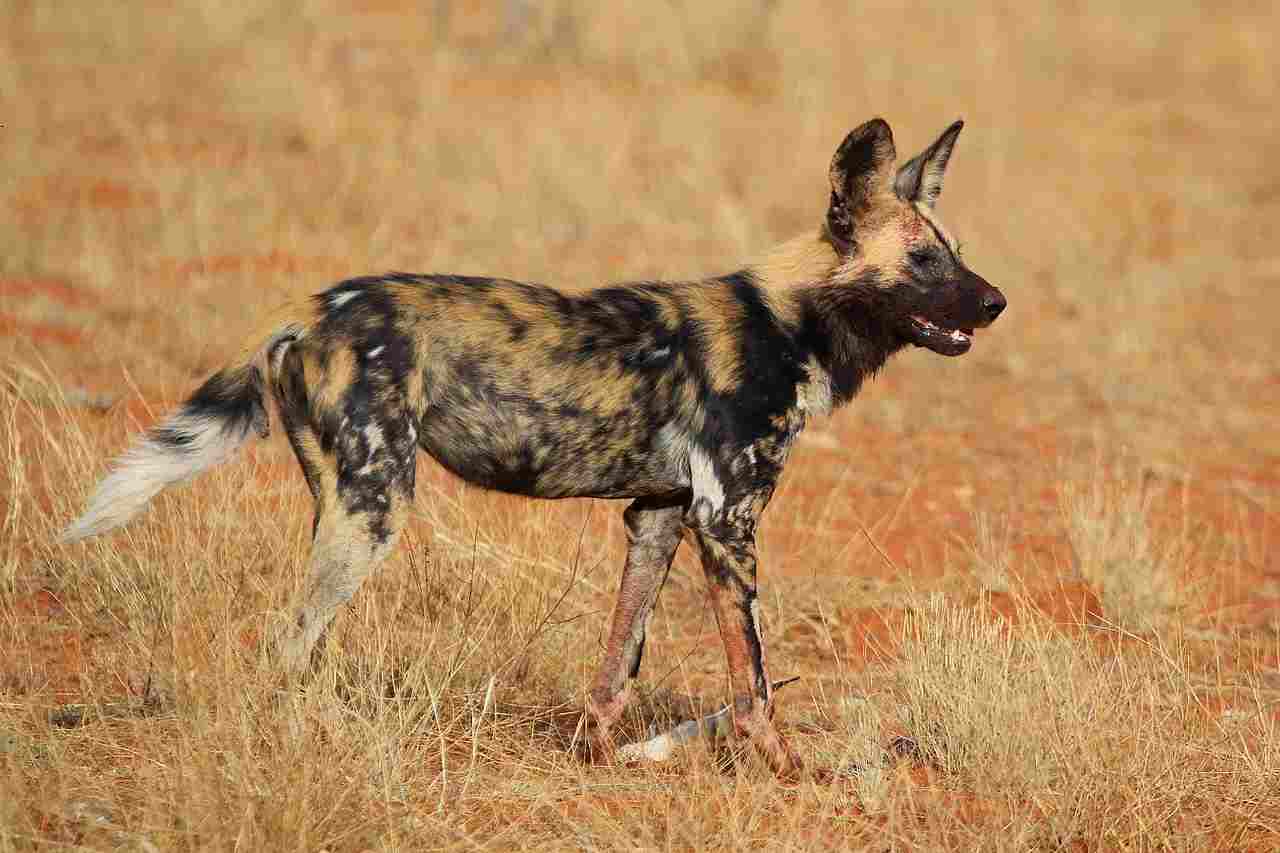
Conclusion
I). SIMILARITIES
When comparing hyenas and African wild dogs, it is evident that these two species share some similarities. Both animals are native to Africa and are known for their social behavior. They live in packs or clans, which are essential for their survival and hunting strategies. Additionally, both hyenas and African wild dogs are highly skilled hunters, relying on teamwork and cooperation to bring down their prey. These similarities in social structure and hunting behavior highlight the adaptability and intelligence of both species.
II). DIFFERENCES
While hyenas and African wild dogs have some similarities, there are also significant differences between them. One notable difference is their physical appearance. Hyenas have a robust build with a sloping back and powerful jaws, while African wild dogs have a slender and agile body structure. Another difference lies in their hunting techniques. Hyenas are opportunistic scavengers, often relying on their powerful jaws and bone-crushing abilities to feed on carcasses. In contrast, African wild dogs are skilled and efficient hunters, relying on their speed and endurance to chase down and capture their prey.
In terms of conservation status, both hyenas and African wild dogs face significant challenges and are classified as “endangered” or “threatened.” However, the specific threats they face differ. Hyenas are primarily threatened by habitat loss and persecution by humans, while African wild dogs face additional challenges such as disease outbreaks and competition for resources.
